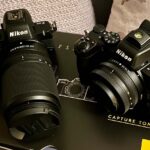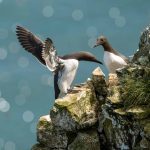In March, towards the end of winter, I decided to take a day off work and try to photograph one of the UK’s five species of owl. I had been following a birding sightings Facebook page and found out about the little owl. I had never seen one before, so I was excited to add it to my list.
Setting up the Shot:
I packed my gear, including my Nikon Z50 camera with a Sigma 150-600c lens and a bean bag. It was a bright but cloudy day, which meant the light was diffused, but not too harsh. I arrived at the location early in the morning and set up my bean bag, camera, and lens. I used a wooden farm fence to rest my camera on and placed the bean bag under the lens to stabilize it. My camera was set to 500mm, F6, and 1/1000s shutter speed. I turned off lens optical stabilization since I was using a bean bag and it should only be used when shooting handheld at slow shutter speeds. It the camera is fixed in place the stabilization shakes the camera and can make images soft.
Getting into Position:
I had never seen a little owl before, so I had no idea what to expect. I had researched the species beforehand and learned that they were often found in farm fields and hedgerows. I found a promising location near a wetlands in Lancashire, where I could spot some farmland and a small copse of trees. I arrived early and waited for the owl to show up. I scanned the area with my binoculars and listened to the bird calls in the distance. It was a peaceful and tranquil setting, but after a few hours, my patience was starting to wear thin. I had brought some snacks and water with me, but they were running out fast. I started to wonder if I had made a mistake in taking the day off work to pursue this encounter. But the biggest part of wildlife photography is patience and enjoying the moment.
Capturing the Moment:
It was getting towards 5 pm, and all of a sudden, the little owl jumped onto a tree and posed for the shot. I was thrilled to have finally captured the moment after waiting for so long. I clicked the shutter button, and the camera captured the image in crisp detail. The owl’s feathers and eyes were sharp, and the blurred background made the bird stand out even more. I took a few more shots, just to be sure, and then sat back to admire the view. The owl stayed there for a few more minutes, looking around, and then flew off. I packed my gear and headed back to my car, feeling elated and satisfied.
Post-Processing:
Back home, I downloaded the photos onto my computer and started to review them. Luckily, there wasn’t much post-processing to do. I adjusted the light levels, saturation, and contrast, and applied a bit of noise removal using Topaz Denoise. I wanted to keep the image as natural as possible, so I didn’t crop or change the composition. The final image looked amazing, and I was proud of my achievement.
Final Thoughts:
Getting the shot of the little owl was an incredible experience. It took a lot of patience, perseverance, and luck, but it was worth it in the end. I learned a lot about the species, their habitat, and behavior, and I felt more connected to nature than ever before. I realized that wildlife photography is not just about capturing a perfect shot, but also about appreciating the beauty and diversity of the natural world. I hope this post inspires other wildlife photographers to keep trying and waiting for the perfect shot, and to remember that the journey is just as important as the destination.
Till next time,
Scott



